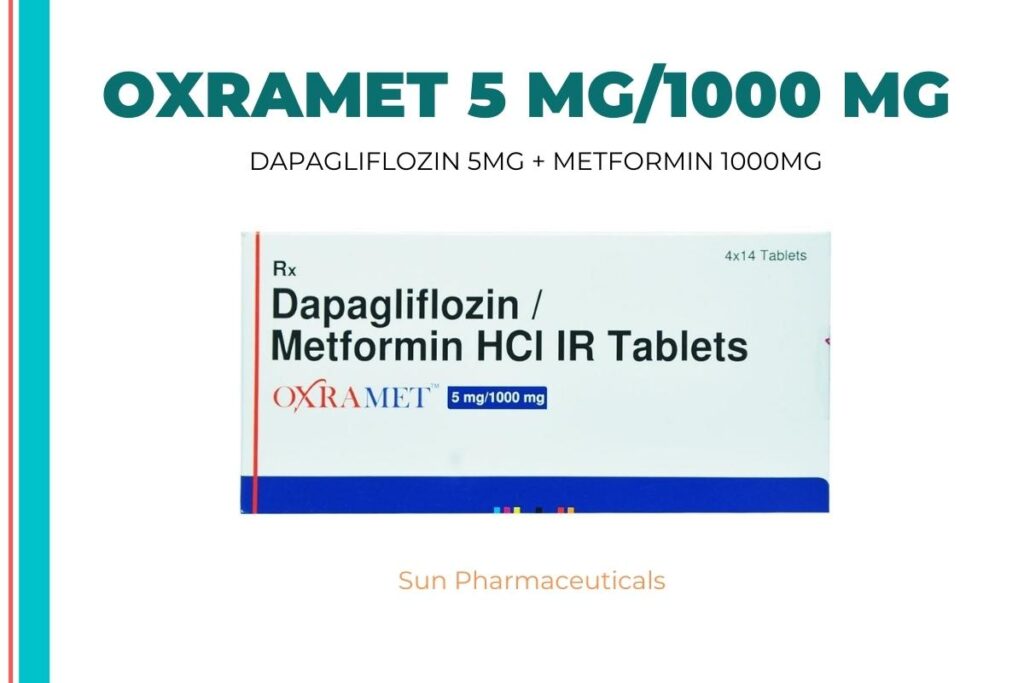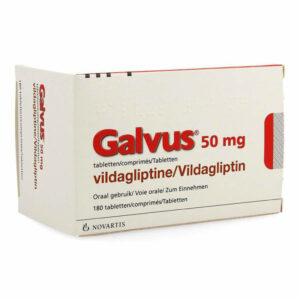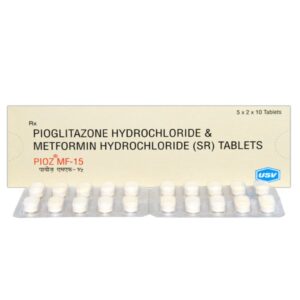Oxramet 5 mg/1000 mg
Oxramet 5 mg/1000 mg is a ‘antidiabetic medication’ that is primarily used to treat type 2 diabetes mellitus in conjunction with a healthy diet and exercise. Additionally, Oxramet 5 mg/1000 mg reduces the risk of heart failure in type 2 diabetic patients with cardiovascular disease. Diabetes mellitus is a metabolic disorder characterized by abnormally elevated blood sugar levels. It happens when insulin (a hormone produced by the pancreatic’s beta cells) is ineffective in breaking down glucose to produce energy (insulin resistance), or when the pancreas (an organ beneath the stomach) produces insufficient or no insulin. The usage of Oxramet 5 mg/1000 mg is contraindicated in type 1 diabetes.
Oxramet 5 mg/1000 mg contains two diabetes medications, Metformin and Dapagliflozin. Metformin is a member of the class of drugs known as biguanides and is used to control blood sugar levels, particularly in obese people. It acts in a nonpancreatic manner, lowering blood glucose without boosting insulin secretion. Dapagliflozin is a member of the gliflozin class of drugs. It works by lowering blood sugar levels by the elimination of excess sugars through the urine.
Take Oxramet 5 mg/1000 mg exactly as prescribed by your physician. Nausea, vomiting, diarrhea, headache, weakness, runny nose, vaginal infection, dizziness, taste changes, and sore throat are some of the more prevalent adverse effects of Oxramet 5 mg/1000 mg. Occasionally, Oxramet 5 mg/1000 mg may cause lactic acidosis (a uncommon but significant metabolic problem caused by an excess of lactic acid in the blood produced by metformin buildup) or diabetic ketoacidosis (excessive synthesis of blood acids (ketones)). These adverse effects are not universal and vary by individual. Consult your doctor if you have any uncontrollable adverse effects.
Oxramet 5 mg/1000 mg may cause hypoglycemia (low blood sugar); therefore, it is recommended to consume a balanced diet with adequate calories and avoid strenuous exercise. Do not take or discontinue this medication unless your doctor has advised you to do so. Notify your doctor before to starting Oxramet 5 mg/1000 mg if you have a medical history of heart, kidney, or liver disease, breathing issues, blood disorders, dehydration, alcohol usage, hypotension, or genital yeast infection. It is recommended that you abstain from alcohol while taking Oxramet 5 mg/1000 mg to reduce your chance of developing lactic acidosis. Oxramet 5 mg/1000 mg is contraindicated in the second or third trimesters of pregnancy or while breastfeeding.
Oxramet 5 mg/1000 mg Indications Type 2 Diabetes mellitus

Medicinal Advantages
Oxramet 5 mg/1000 mg is a combination of Metformin and Dapagliflozin that is used to treat type 2 diabetes mellitus. Metformin is a biguanide that helps people regulate their blood sugar levels, particularly those who are obese. It acts in a nonpancreatic manner, lowering blood glucose without boosting insulin secretion. Additionally, it is referred to as an insulin sensitizer since it enhances the effects of insulin. Metformin is a unique anti-diabetic medication because it does not cause hypoglycemia (lowered blood sugar levels). Dapagliflozin is a member of the gliflozin class of drugs. It works by lowering blood sugar levels by the elimination of excess sugars through the urine. Additionally, Oxramet 5 mg/1000 mg lowers the risk of heart failure in people with type 2 diabetes and cardiovascular disease. Oxramet 5 mg/1000 mg may be prescribed in conjunction with or in lieu of other drugs, as well as diet and exercise, to help regulate blood sugar levels.
Tablet: Swallow the entire tablet of Oxramet 5 mg/1000 mg with a glass of water. Avoid chewing, crushing, or breaking the tablet. Take Oxramet 5 mg/1000 mg preferably with a meal to avoid hypoglycemia and gastrointestinal side effects. Your doctor may begin with a low dose and gradually increase it to a level that achieves the desired blood glucose control.
Storage Keep out of direct sunlight and in a cool, dry area.
Oxramet 5 mg/1000 mg Adverse Reactions
Nausea
Vomiting
Diarrhea
Headache \sWeakness
Nose runny
Infection of the genitalia
Dizziness
Changes in flavor
Throat irritation
Acidosis lactica (rare)
Ketoacidosis in diabetics (rare)
Adverse Drug Reactions
Notify your doctor if you are already on any other antidiabetic medications so that the dosage of Dapagliflozin and Metformin can be changed appropriately. Do not abruptly discontinue Dapagliflozin and Metformin if your doctor has not advised you to do so. Dapagliflozin with Metformin may cause hypoglycemia (low blood sugar); as a result, it is recommended to consume a balanced diet with adequate calories and avoid strenuous exercise. Before taking Dapagliflozin and Metformin, inform your doctor if you have any heart, kidney, or liver disease, breathing problems (asthma, obstructive lung disease), blood problems such as anemia (lack of red blood cells), vitamin B12 deficiency, pancreas problems/surgery, dehydration, alcohol use, low blood pressure, or genital yeast infection. Avoid alcohol consumption while taking Dapagliflozin or Metformin, as it may raise your chance of developing lactic acidosis. It is not recommended to take Dapagliflozin or Metformin during the second or third trimester of pregnancy or during breastfeeding. In such circumstances, your doctor may recommend different drugs to manage your diabetes. Dapagliflozin and Metformin are not suggested for anyone under the age of 18 years.
Interactions Between Drugs
Dapagliflozin and Metformin may interact with diuretics (hydrochlorothiazide), analgesics (ibuprofen, celecoxib), acid-reducing medications (cimetidine), asthma medications, blood pressure-lowering medications, and corticosteroids.
Avoid alcohol consumption as it raises the risk of lactic acidosis.
Before taking Dapagliflozin with Metformin, inform your doctor if you have any heart, kidney, or liver disease, breathing issues, blood disorders, dehydration, alcohol usage, or low blood pressure. In individuals with significant renal impairment and metabolic acidosis/diabetic ketoacidosis, dapagliflozin and metformin are contraindicated.
Safety Recommendations
ALCOHOL
It is recommended to abstain from alcohol use as it may exacerbate adverse effects such as lactic acidosis and raise the chance of developing hypoglycemia.
PREGNANCY
It is not recommended to take Dapagliflozin or Metformin during the second or third trimester of pregnancy. Your doctor may also recommend additional medications to help you manage your blood sugar levels. Consult your physician before to initiating Dapagliflozin and Metformin if you are pregnant or expecting to become pregnant.
BREAST FEEDING
Dapagliflozin and Metformin may be dangerous to take while breastfeeding due to the fact that they are excreted in breast milk. Please see your physician for additional information.
DRIVING
If your blood sugar levels are too high or too low, it may impair your driving. Avoid driving or operating machinery if you have blurred vision, dizziness, or drowsiness as a result of severely low or high blood sugar.
LIVER
When administered Dapagliflozin with Metformin, inform your doctor if you have a history of liver disease or hepatic impairment.
KIDNEY
In patients with severe renal impairment/kidney disease, dapagliflozin and metformin are contraindicated. When taking Dapagliflozin with Metformin, inform your doctor if you have a history of kidney illness.
No.
Advice on Diet and Lifestyle
If you are using Dapagliflozin and Metformin more than once per day, take the medication exactly as advised by your doctor and at regular intervals. When taking Dapagliflozin with Metformin, do not use any additional over-the-counter drugs, herbal supplements, or vitamin supplements without first consulting your pharmacist or doctor.
Maintain a fiber-rich diet rich in fruits, vegetables, and whole grains to help control your blood glucose levels.
Consume food at regular intervals.
Maintain a healthy weight and engage in regular exercise to keep your heart healthy.
Additionally, your doctor will educate you on how to recognize and manage the early symptoms of high/low blood sugar levels.
Simple lifestyle changes can help manage gastrointestinal side effects. These include a reduction in sugar and fatty foods, as well as an avoidance of carbonated beverages and foods that induce gas.
Special Guidance
It is recommended that you monitor your blood sugar levels on a frequent basis.
If you are scheduled for an x-ray or CT scan that requires the injection of a dye into your veins, your doctor may recommend temporarily discontinuing Dapagliflozin and Metformin.
While taking Dapagliflozin with Metformin, it is recommended to assess kidney function on a regular basis.
Dapagliflozin and Metformin may cause you to test positive for a urine glucose test; thus, advise your doctor that you are taking Dapagliflozin and Metformin in advance.
Additionally, this item is non-returnable.
Concern for Patients
Diabetes mellitus, alternatively referred to as adult-onset diabetes, is a metabolic disorder characterized by elevated blood sugar levels. Type 2 diabetes occurs when insulin (a hormone produced by the pancreas’s beta cells) is ineffective in breaking down glucose to produce energy (insulin resistance) or when the pancreas (an organ beneath the stomach) produces insufficient or no insulin at all. This condition is more prevalent in persons over the age of 40, but it can also occur in children, depending on the risk factors. Treatment consists of oral glucose-lowering medications and insulin injections.
FAQs
Metformin and Dapagliflozin are two anti-diabetic medications contained in Oxramet 5 mg/1000 mg. These medications help to control blood sugar levels in type 2 diabetes mellitus by removing excess sugars through the urine and also by enhancing insulin action.
Dapagliflozin and Metformin both have the potential to produce low blood sugar (hypoglycaemia), which can make you feel hungry, dizzy, angry, confused, anxious, or shaky. As a result, it is recommended that Dapagliflozin and Metformin be taken with food. To cure hypoglycemia quickly, it is recommended to consume or consume fast-acting sugar sources such as fruit juices, hard candy, raisins, or non-diet cola.
Dapagliflozin and Metformin may be prescribed in combination with or without other drugs to help regulate your blood sugar levels. However, it is recommended to keep a healthy diet and exercise routine when taking Dapagliflozin and Metformin alone or in combination with other antidiabetic medications.
Dapagliflozin and Metformin should be used with caution in patients with heart, kidney, or liver disease, breathing problems (asthma, obstructive lung disease), blood disorders (anemia, vitamin B12 deficiency), dehydration, alcohol use, low blood pressure, pancreas problems/surgery, and genital yeast infection. In individuals with significant renal impairment and metabolic acidosis/diabetic ketoacidosis, dapagliflozin and metformin are contraindicated.
If you suffer vomiting, stomach/abdominal discomfort, muscle cramps, a nauseous sensation, severe fatigue, difficulty breathing, or decreased body temperature and heartbeat while using Dapagliflozin with Metformin, it is critical to seek immediate medical attention as these are indications of lactic acidosis. Lactic acidosis is a rare but dangerous condition associated with metformin buildup. This is a medical emergency that requires quick attention. Consult your physician for additional information.
Dapagliflozin and Metformin should not be used in conjunction with water pills/diuretics. Simultaneous usage of Dapagliflozin and Metformin, as well as water pills, dehydrates the patient and increases the chance of developing lactic acidosis.
As soon as feasible, take the missed dose. If, however, the next dose is approaching, skip the missing dose and resume your regular dosing plan. Contrary to popular belief, do not double the dose.








Leave a Reply
You must be logged in to post a comment.